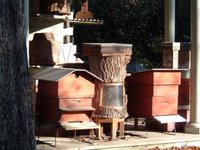
LE JARDIN DU LUXEMBOURG
(le ruche, or apiary, left, at the Luxembourg Gardens)
I've been going to the Luxembourg Gardens in the late afternoon this week. The light at this time of day is softer, and I'm generally fatigued from the duties and pleasures of the day. I head down the rue de Fleurus, where Gertrude Stein and Alice B. Toklas made their lives together in the last century, and I walk the two short blocks from my apartment to the entrance gate at rue Guynemer. Guynemer was a World War I-era pilot, killed in action near the end of the war.
If you follow the main paved pathway from this entrance, it takes you past the tennis courts and the ponies to the Grand Bassin, where children launch small wooden sailboats with cotton sails for three euros an hour. The bassin is at the heart of the garden. It's where my father heads each time he visits the Luxembourg, and in choosing a green iron armchair under a potted palm, he joins the many tourists and visitors who are drawn here too.
I, on the other hand, prefer the garden's many quiet corners, where old men cluster in groups to talk, or to play petanque on the hidden-away courts reserved for this game. Women, too, sit together, more often in twosomes, and young lovers express their yearnings, squeezed together on a single chair or more comfortably on a garden bench. Street people and lunatics gravitate to the recesses of the garden as well, though they are always on best behavior here and bother no one.
Entering the garden, my pulse slows and my breathing relaxes. There's something soothing about being here. The giant beeches, oaks, and chestnut trees spread their branches across the carefully groomed pelouses (lawns), off of which the blue-suited Paris police regularly chase picnickers, children, and dogs. Everywhere there are flowers--in beddings, spilling out of urns, or clustered around elegant statues. The other day, I discovered the garden's miniature artist's model of the Statue of Liberty. She too was surrounded by blooming plants.
It strikes me that there's nothing exotic or fancy about anything that grows here. The gardeners work with simple, everyday plants--geraniums, pansies, salvia, nicotiana, lantana, marigolds, and later in the fall, mums. Yet everything is carefully tended, and much attention is paid to the aesthetics of color, size, and shape.
Today, I head toward the experimental gardens, where fruit trees are growing in rows along the fence on the rue Auguste Comte side of the garden. I spot a chair with a perfect westward orientation, and as I walk toward it, I discover that the garden keeps bees as well. They're buzzing around a number of wooden bee hives, and I wonder if the apiary produces honey for purchase. A group of four young French women are seated near my chair, laughing and chatting happily together. I imagine they'll be coming here across the next fifty years; this is a practice run for what will become a way of life.
I sit down in my chair, take off my shoes to let my feet feel the warmth of the sun, and pull out my pen and the two postcards I've bought for people at home. The air has a light camphorlike smell I've also noticed near the sea in the south of France. I've never known exactly what creates this scent, whether it's related to moisture in the air, a certain flower or evergreen shrub, or some combination of each element. I love it and wish that, instead of the various physical items I'll be stuffing into my bags for the return trip, I could bring some of the Parisian air home with me.
I write my postcards and eat an apple. A businessman walks by, a young man with a grey cat on a leash amble past, and three police officers do their duty, chasing the many transgressors off the manicured lawns. Small signs posted everywhere make it clear that the pelouses are strictly off limits. Checking my watch, I see that it's time to head home for dinner. As I walk slowly through the garden, I take a slightly different path out, wandering past a large playground bursting with children and their parents. Beyond the playground, the noise level drops, and I marvel that everyone in the park--besides the children--seems to be reading: books, newspapers, magazines, reports, letters, palm pilots, anything in script. I make a mental note. Tomorrow, I'll bring my copy of "Le Monde."

No comments:
Post a Comment